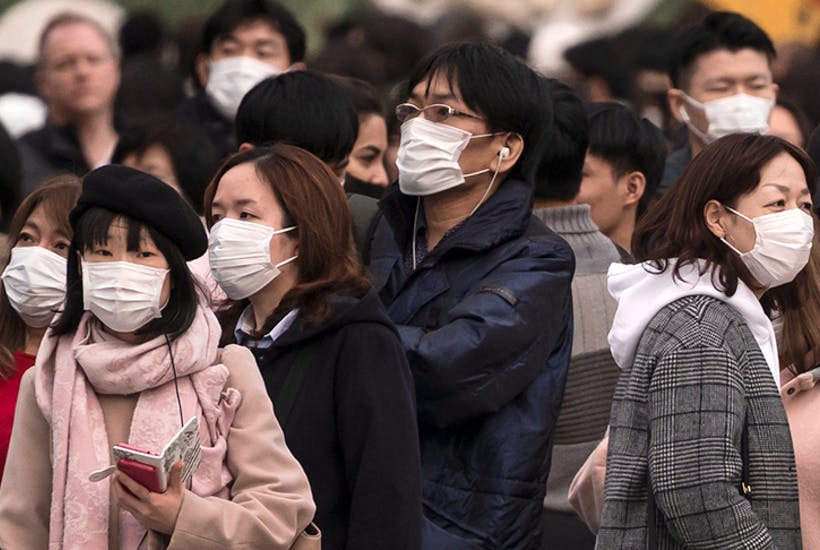If you have just cancelled your trip to Venice and ordered your £19.99 surgical face mask from Amazon, how about this for a terrifying vision: by the time we get to April, 50,000 Britons will have succumbed to a combination of infectious disease and adverse weather. Frightened? If you are, don’t worry: you survived. It was two years ago. In 2017-18 the Office for National Statistics recorded 50,100 ‘excess winter deaths’. The explanation, according to the ONS, was probably ‘the predominant strain of flu, the effectiveness of the influenza vaccine, and below average winter temperatures’.
Coronavirus (Covid-19) is a pretty virulent virus all right, but not in the way you might imagine. It is less our respiratory tracts it has infected than our inner sense of angst. By last Monday there were 79,331 confirmed cases worldwide, all but 2,069 of which were in China. There have been 2,595 deaths in China and 23 elsewhere in the world. And seasonal flu? According to an estimate by the US-based Center for Disease Control and Prevention, it has caused between 291,000 and 646,000 deaths globally a year. To put it another way, if the number of deaths from coronavirus rises a hundredfold in the next few weeks or months, it will only have reached the lower bound of the estimate for existing strains of flu.
How many of us wear face masks because of winter flu? How many planes and trains are cancelled? Does the stock market slump? There is some justification for being more wary of Covid-19 than the flu. The former is an unknown quantity and we don’t yet have a vaccine. But we know more about it by the day. Its death rate is now around 1 per cent or less and it is mostly killing people with pre-existing health conditions; anyone else would be unlucky to die from it.
Coronavirus hysteria occurs because we confuse precaution with risk. We see Chinese cities being cut off, people being quarantined, factories closed, the streets emptying (save for a few people in face masks) and we interpret this as a sign of grave and imminent danger. If China had not taken such dramatic steps to stop the disease, we wouldn’t be half as worried.
There seems to be a distinct strain of Sino-phobia in our attitude towards infectious disease. Every novel disease that comes out of China instantly seems to gain the description ‘pandemic’ — even when diseases such as Sars and H5N1 avian flu hardly justify being called an ‘epidemic’. Covid-19 seems to fit neatly with our fears about Huawei spying on our phones and Chinese manufacturers stealing our jobs. Diseases from elsewhere don’t excite the imagination nearly so much. There was a brief flurry of concern in 2014 when Ebola, vastly more lethal than Covid-19, emerged in West Africa (it has since killed 11,310 people globally). But if we are going to worry about any infectious disease, it ought to be tuberculosis. The World Health Organization reports there were ten million new cases worldwide in 2018, 1.45 million deaths, and 4,672 cases in England. But no one ever bought a face mask because of that. How many people even know that the epicentre of tuberculosis is India, with 27 per cent of cases globally?
There is something more to the Covid-19 panic. It is the latest phenomenon to fulfil a weird and growing appetite for doom among the populations of developed countries. We are living in the healthiest, most peaceful time in history, yet we cannot seem to accept it. We constantly have to invent bogeymen, from climate alarmism, nuclear war and financial collapse to deadly diseases. Covid-19 has achieved such traction because it has emerged at just the right time. At the end of January, Brexit had just been completed without incident. The standoff between the US and Iran — which preposterously led the ‘Doomsday Clock’ to be advanced closer to midnight than during the Cuban missile crisis — fizzled into nothing. The Australian bush fires, which caused an explosion in climate doom-mongering (even though the global incidence of wildfires has fallen over the past two decades) had largely gone out. What more was there to worry about?
Then along came a novel strain of disease and the cycle of panic began again. But there are already strong signs that it has peaked. In the seven days before 24 February, the WHO recorded 6,398 new infections in China — down from 13,002 the previous week. On Monday it was 415. Very soon we are going to have to find another thing to agonise about. Asteroids? The next ‘freak’ weather incident, now the storms have died down? Who knows, but we will certainly find something.
This article is free to read
To unlock more articles, subscribe to get 3 months of unlimited access for just $5








Comments
Join the debate for just £1 a month
Be part of the conversation with other Spectator readers by getting your first three months for £3.
UNLOCK ACCESS Just £1 a monthAlready a subscriber? Log in